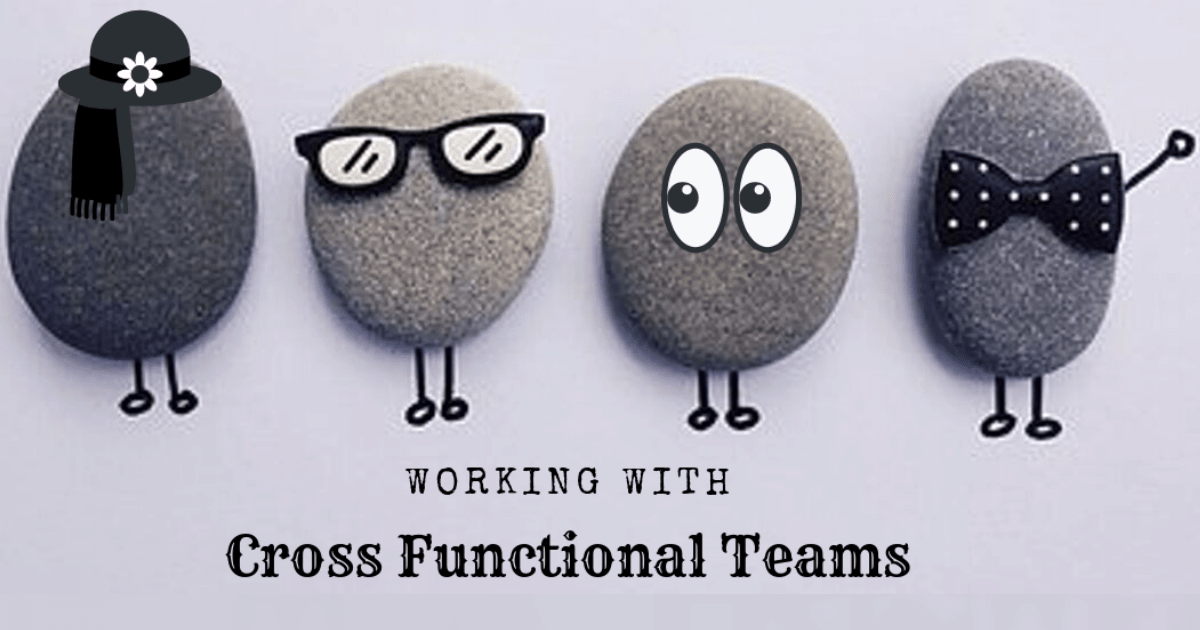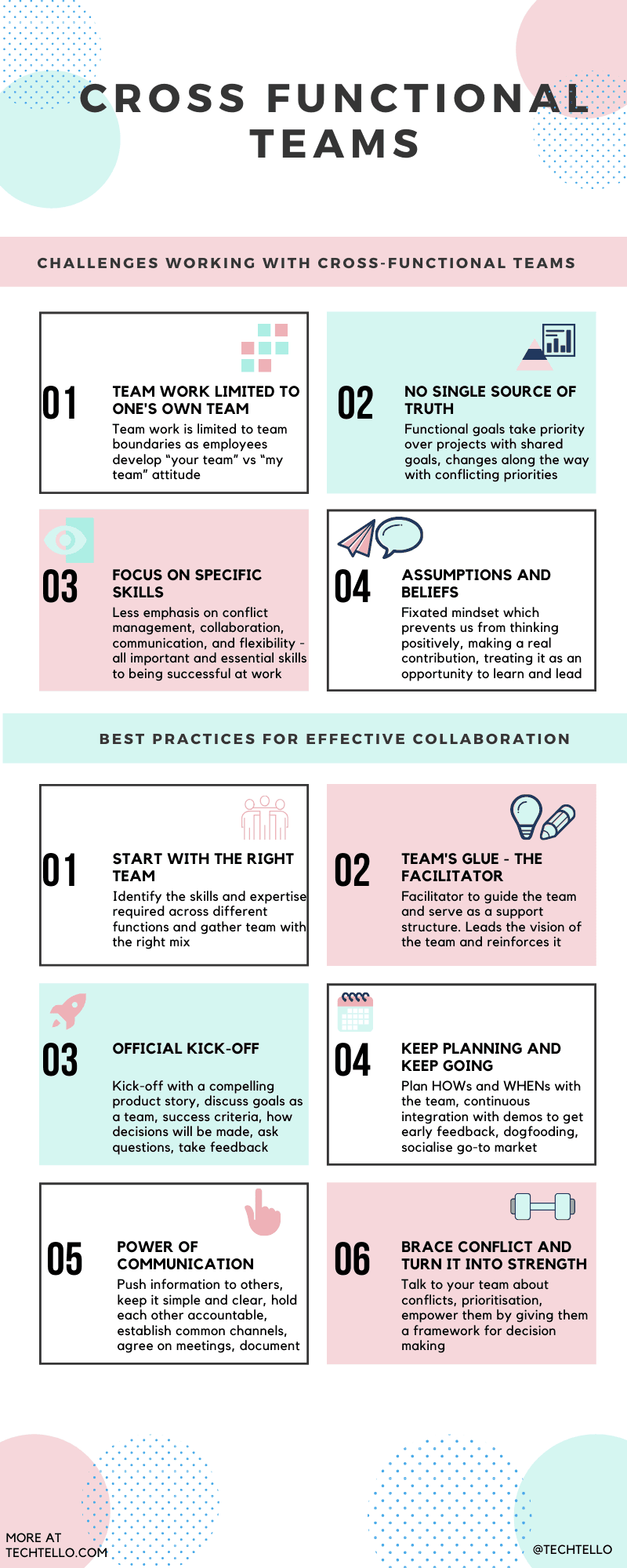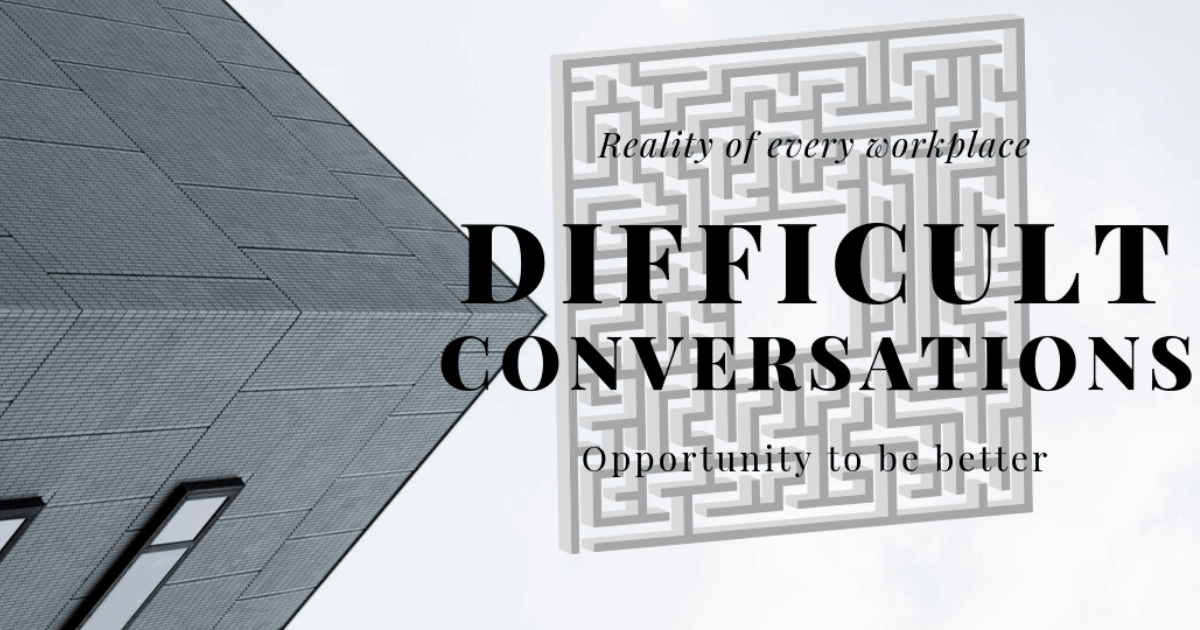Working With Cross Functional Teams: Master Effective Collaboration In The Workplace

As I played multiple roles in cross functional teams over years – developer on a small part of the product to leading engineering teams to guidance in a leadership role, I experienced feelings of frustration, anger, disappointment and at times even helplessness. With continued focus on cross functional team collaboration in every organisation, I failed to understand why there’s so little investment in setting up these teams for success.
I spoke to multiple people in different organisations to try and get some answers but got responses that described the problem itself:
- It’s too complex
- Things work out eventually in a cross functional team
- Delays are natural in such a setup
- People focus on their part and miss the bigger picture
- Bringing everyone together and making them speak the same language is challenging
- Understanding people is not easy and you have to deal with a lot of them in a cross team collaboration
- Don’t overthink, it’s not that bad
- If you compare to last year, things have definitely improved
It felt like living in a state of denial. I could not accept it and questioned myself “Are these feelings inevitable while working with cross functional teams. Do I really have to learn to deal with them. Is there no better way?”
I struggled my way through it with multiple failures and setbacks, each one shouting like a voice in my head “I can’t do this anymore, I can’t take this anymore”.
I took inspiration from The Hard Thing About Hard Things, Ben Horowitz
In the technology game, tomorrow looks nothing like today. If you survive long enough to see tomorrow, it may bring you the answer that seems so impossible today.
Despite all the negative emotions I had to deal with, I did not give up – being part of a cross functional team and observing different groups at play was somehow inspirational. Instead of approaching it with a problem mindset, I decided to study cross functional teams with an open mindset:
- What are the unique characteristics of a cross functional team?
- What are its basic building blocks?
- What is vital for its success?
- What are the challenges faced by such teams?
- Who are the key players in it?
- Can conflicts be dealt with positively, can they serve as a means to proactive thinking?
- Does it require a discipline aligned with its unique challenges?
I thought, there must be a way, a better way of doing things. I need to find it for myself, for my team as I owe it to them. It won’t be easy, but the light at the end of the tunnel will keep me going. I decided to shift from taking a role in the drama triangle to taking responsibility for driving a change. There’s so much to learn.
While I have definitely not mastered it as each cross functional team brings its own set of challenges, I will share a few learnings that can be helpful to anyone looking to effectively implement it in their organisation and benefit from it.
Collaboration Challenges with Cross Functional Teams

As we faulter, we try to find fault in others, make our peace by thinking it’s someone else’s problem. Most of us do that at the workplace when faced with difficult situations. We also try to alleviate problems through a quick patchy solution without understanding its long term impact. This behaviour gets intensified in a cross functional setup with unknown challenges, high expectations and missing support system to deal with it.
While working with cross functional teams should enable people to step up and learn new skills, an opportunity to go beyond tasks, learn and practice leadership skills, it hardly works that way. It looks like a mad powerhouse with few key decision makers and everyone else simply there to do their job (and nothing more).
Why does something so powerful work this way? We cannot learn and experience it without fear of failure. Only then we can truly contribute.
As Mark Zuckerberg, founder of Facebook said “The only strategy that is guaranteed to fail is not taking risks”
Team work limited to one’s own team
There is a lot of talk in organisations around teamwork, leaders and managers speak about it all the time. It has definitely benefited each team as a lot of value is generated by people working closely together as a group. Yet its benefits get limited to team boundaries as employees develop “your team” vs “my team” attitude. They view their functional team (with reporting hierarchy) as their primary team and everything else secondary.
Managers (knowingly or unknowingly) strengthen this feeling amongst its team members as they fight to build products for their teams while showing resistance to requests from other teams or functions. This behaviour finds its way to their team members unconscious bias influencing their thinking and decision making.
This unconscious bias establishes superiority about one’s own team and work, makes us unwilling to learn about other teams. Poor understanding of other teams work and their challenges along with our past perceptions of working with specific people from certain groups causes resistance while dealing with people outside one’s own functional team.
Outcome is execution silos with managers controlling their teams (and their output) in the name of being protective about their team members.
What do you think will happen when some of these people become part of a cross functional team?
No single source of truth
Every team despite their best effort deals with prioritisation problems. Functional goals take priority over projects with shared goals (especially if team is not driving it), priorities change along the way with new commitments, conflicting priorities continue to live with no clear answer.
At times there’s also alignment missing at the leadership level causing further confusion within teams. As these teams set out to deal with competing commitments (sometimes too many of them), they each do it in their own way.
One or more of the following may happen
- Ad-hoc allocation of resources to projects as new information unravels
- Reshuffling of resources to projects
- Stop work-in-progress to make way to new priorities
- Delay in getting the right people on important projects as they get busy with other commitments
- Endless debate on my priority vs your priority
Different signals and often confusing ones will make people take wrong decisions around priorities which causes disagreement and dissonance amongst teams.
What do you think will happen when some of these people become part of a cross functional team?
Focus on specific skills
Employees in tech roles focus on learning new technical skills and strengthening existing technical knowledge. That’s good and absolutely required. Mentorship and coaching (formally or informally) in companies is also directed towards it.
There’s continuous emphasis on meeting timelines and getting tasks done. But getting work done requires more than technical knowledge. It requires conflict management, collaboration, communication, and flexibility – all important and essential skills to being successful at work.
You would ask, isn’t this the manager’s responsibility?
Absolutely No. Every person in tech should learn these skills irrespective of whether or not they decide to take on the managerial path. These skills are essential to their own growth and success of an organisation.
As employees are not taught these important skills, productivity takes a hit
- Managers and leaders need to intervene every time there’s a conflict as their team is not enabled to make decisions
- Team members do not communicate proactively and wait for others to come and pull information
- They become inflexible to change and avoid it as change leads to conflict and conflict is considered bad
- Ineffective collaboration between different teams as they spend their time on disagreements and proving others wrong instead of trying to get things right
What do you think will happen when some of these people become part of a cross functional team?
Assumptions and beliefs
Humans are driven by assumptions and beliefs that they hold. We make assumptions about our own team, our manager, people and work on other teams. These assumptions along with our past experience from working with others makes our belief stronger.
Some of the common assumptions (and also points of fear) about cross functional teams
- I won’t be allowed to make choices and will have to compromise on quality for speed of delivery
- There will be no learning
- Requirements will change often leading to rework, which will be a waste of my potential
- I do not like too much discussion and too many meetings. I am better suited to projects that require more individual contribution
- I do not have much context on that area of work. I think someone else might be better suited to take it up
These assumptions and beliefs lead to a fixated mindset which prevents us from thinking positively, making a real contribution, treating it as an opportunity to learn and lead.
What do you think will happen when some of these people become part of a cross functional team?
Best Practices for Better Cross Functional Team Collaboration

Start with the end in mind –— Stephen R. Covey, The 7 Habits of Highly Effective People
While I make an attempt to describe some of the best practices that can enable effective cross team collaboration, it will be your willingness to embrace and drive change while managing all the drama at work which will make it successful.
Any change in an organisation is a lot of hard work, it won’t be easy, be firm and do not give up in the event of a pushback. Remind people that you are not doing this out of a personal agenda or trying to be superior by making a point, you are doing this for the team and this company. Talk openly about the problems, be careful with words – approach it with a solution mindset and not complaining attitude, request for support to experiment and learn. Start by socialising the change within smaller groups, gain their trust and then use the collective power of more people to drive larger changes. Identify some quick wins and then move towards bigger and more complex changes.
Believe in the collective strength of people with different backgrounds and knowledge. They can do wonders together. It’s only about making them speak the same language. So, try you must. Your efforts will make a difference.
Start with the team
Setting up the right team is the first most important step
- Identify the skills and expertise required across different functions
- Learn about dependencies – who needs whom to make a decision
- Work with managers and leaders across these teams and functions to plan resources, establish time commitment, priority, expectations, short term vs long term needs of these individuals on their team. Treat only a firm yes (and not I will see later or let me work it out) as a positive sign of commitment
- Socialise team structure and team requirements with others to gather feedback and avoid missing anyone
Do this as you start, not later, not in the end even if there’s a small dependency on some teams. Involving each team from the beginning will keep expectations aligned and help these teams better manage their resources.
Team’s glue – The facilitator
Every cross functional project needs a facilitator (or two) to guide the team and serve as a support structure. Facilitators role is a key one as it requires many important leadership skills
- Facilitator must be a great story teller. Stories bring people together and a facilitator who can create a compelling product story can appeal to its team as it helps them find a connection and attach meaning to their work
- Establishes psychological safety by being flexible, adaptable to change and being a good listener
- Leads the vision of the team and reinforces it by revisiting goals with the team regularly
- Coaches team to proactively identify roadblocks
- Establishes communication guidelines and demands clarity around progress
- Encourages team to work outside their comfort zone, use vulnerability as a means to learn and pushes team to make the best out of it
- Presents data and facts in a format that’s easy for everyone to understand
- Motivates team to embrace conflict and turn it into a positive outcome
Official kick-off
Once a team across different functions is identified, officially kick-off the project with the entire team. Kick-off meeting can also include managers and leaders of different teams to ensure they are aligned and committed to the project
- Start with a compelling product story that outlines the vision – What is the problem, Why are we trying to solve it, Who benefits from it, What does it mean to this team, company and its customers, What will happen if we don’t solve it. It should be the WHAT, WHY and WHO without covering the HOW
- Take a few minutes to let everyone introduce themselves
- Outline collective goals as a team
- Lay out success criteria of the project along with success metrics
- Discuss (and not define) how priorities will be determined and decisions will be made. This will be the first step in establishing how everyone on the team needs to act like an owner
- Talk about the need to push beyond boundaries, work as a team, cooperate and collaborate to ensure learning is not restricted to their functional team. Give few examples of how people can step up in their roles and learn leadership skills
- Introduce the facilitator(s) and their role in this project. In most cases, it will be the same person doing the kick-off.
- Ask questions, take feedback and be proud for a moment to have started things on the right note
Plan ahead to keep building
Plan HOWs and WHENs with the team
- Identify individual goals per team
- Agree on constraints and important decisions that need to be made early to circumvent bigger changes at a later date
- Ensure operational roll out plan is discussed as a team to validate assumptions and identify gaps in the beginning itself and avoid learning about them at a later date. A change in operational roll out strategy can have a large impact on the overall product and its important to get it right
- Work out dependency chain to identify the order in which decisions need to be made and product needs to be built to ensure it all fits together within minimum time frame
- Create a detailed plan that outlines who needs to do what by when. While it’s essential to build a detailed plan at this stage, be aware that it will change and evolve as project progresses. Account for it
- Use continuous integration with weekly demos to get early feedback about the product. Align on the objective of demos and who needs to participate during review. These demos will help uncover expectation mismatch and resolve blockers sooner as it brings team together on smaller achievable goals
- If your company utilises dogfooding before officially launching the product, budget and plan for it
- Socialise go-to market date with the team, other managers and leaders to sensitise around timelines
Power of communication
Good communication and understanding is vital to the success of any project. In a cross functional team with people from different backgrounds, it is essential to survive.
Talk to the team about the importance of good communication and how things fall apart in teams where people communicate poorly. Ask the team a simple question “How should we communicate”. You will find most of these answers (and then add your own)
- Push information to others. Do not wait for others to ask
- Keep it simple and clear so that others can understand
- Communicate to hold each other accountable
- Over communicate to emphasize important information. Make sure you are being heard.
- Make all documentation easily available and accessible to all team members
- Establish common channels for communication – hangout, slack, meetings
- Agree on meetings – agenda of the meeting, who needs to participate, at what frequency
- Document meeting notes, action items, decisions taken and encourage every team member to contribute to it
Every time you find gaps in communication, remind people of the discussion.
Brace conflict and turn it into strength
Conflicts are reality the of a workplace. It signifies employees are thinking and questioning instead of simply accepting. What matters is how these conflicts are resolved.
Talk to your team about conflicts and how they can use it as an opportunity to find a better solution. Empower them by giving them a framework for decision making – How to make decisions, Who to involve, Who has the final say when there are multiple opposing views.
Talk to them about prioritisation and how saying no is vital to the success of any project. Transparency and right intentions with the objective to seek alignment will turn any conflict into a positive outcome for the betterment of the team, product and the company.
It’s always beautiful to see a working product that has taken the effort of multiple people over many days and months. This is just the beginning. There will be many opportunities to work on cross functional teams. So take time out to celebrate success with the team and learn what can be improved through retrospectives.
This topic is very close to my heart and I will be super excited to hear from you about your experiences of dealing with cross functional teams.






























